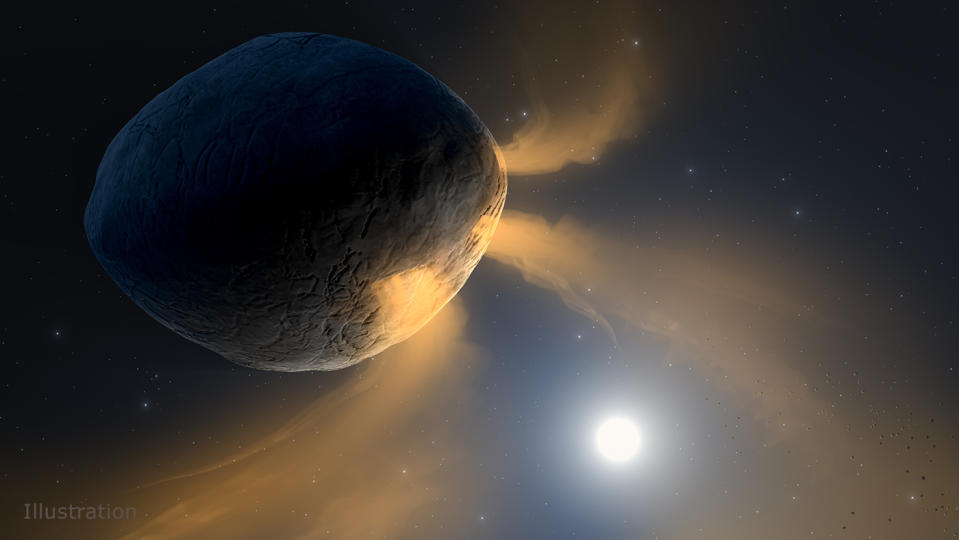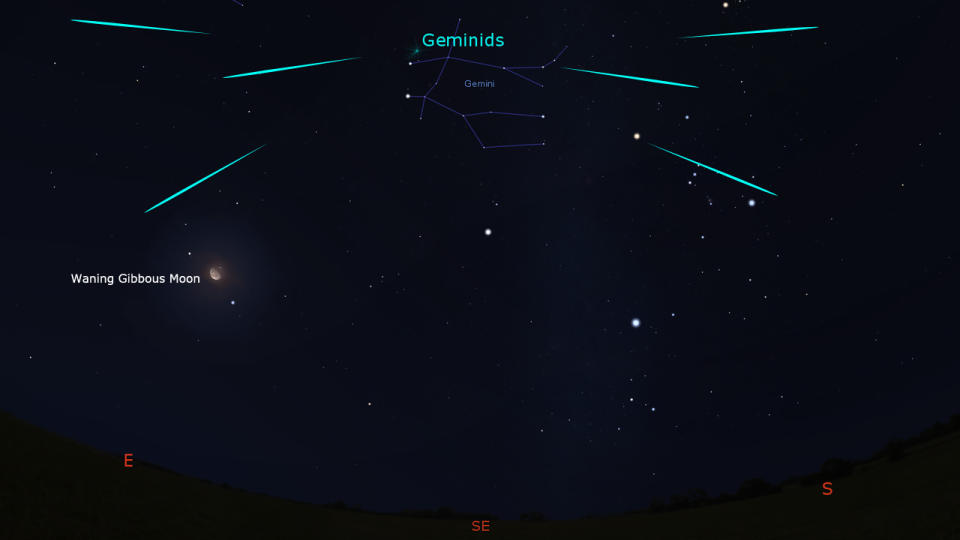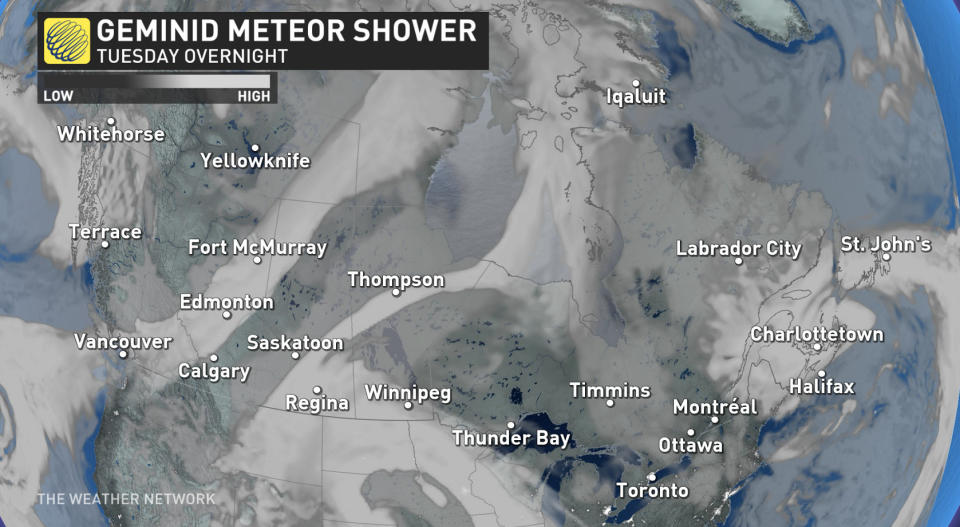Look up! The Geminid meteor shower peaks tonight!

Have clear skies tonight? Head outside overnight to see the peak of one of the best meteor showers of the year — the Geminids.
As Earth travels in its yearly orbit around the Sun, our planet encounters random bits of rock and dust left over from the solar system's origin. When these meteoroids plunge into the atmosphere, they cause flashes of light in the sky that we call meteors.
At certain times of the year, however, we pass through concentrated streams of these meteoroids, each left behind by a comet or asteroid. These result in meteor showers, each one named for the constellation nearest to where the meteors originate in the sky. And each of these meteor showers has one particular night on which they peak, where we can see the greatest number of meteors.

This simulation shows the orbit of 'rock comet' 3200 Phaethon, which is littered with gravel and dust that it leaves behind as it travels around the Sun. The size of the debris is exaggerated here to make it easier for us to see. Credit: Meteorshowers.org/Scott Sutherland
Tonight, from Tuesday, December 13 to Wednesday, December 14, we reach the peak of the Geminids meteor shower.
Originating from a rocky 'extinct comet' named 3200 Phaethon, the Geminids are one of the best and brightest meteor showers of the year.

This illustration shows what a 'rock comet' like 3200 Phaethon may look like. Credit: NASA
Firstly, this meteor shower consistently produces between 100-150 meteors per hour at its peak. So, when observing them at the peak from under ideal conditions (a clear, moonless sky, with the radiant directly overhead), we could see an average of two every minute. Second, Geminid meteors tend to be bright, thus making them harder to miss as they flash by overhead. Thirdly, the meteors can even show up in different colours due to the minerals and metals contained in the meteoroids.
Note: to see the ideal number of meteors (the 'Zenith Hourly Rate'), mentioned above, an observer usually needs to be far from city lights. The average observer tends to see about half that number, with urban light pollution and moonlight reducing that number further.
While the meteor shower is happening all night long, the absolute best time to watch the peak of the Geminids tends to be in the hours after midnight, on the morning of December 14. That is when the radiant is highest in the night sky, and we are essentially looking straight into the oncoming debris stream of 3200 Phaethon.

The location of the Geminid meteor shower radiant on the night of December 13-14, 2022. Credit: Stellarium
However, to get the most out of the meteor shower, time your viewing for when you will have the clearest sky above.
Will we see it?
Three things tend to limit how many meteors we see — clouds, urban light pollution, and the light from the Moon.
Below is the forecast cloud map for across Canada, Tuesday night through Wednesday morning.

Based on this, the regions of the country that are expected to have the best view are central B.C., southern and northern Alberta, central and northern Saskatchewan, central Manitoba, southern and western Ontario, and southern Quebec. Check your local forecast to be sure.
Urban light pollution is a consistent issue for astronomy and night sky observation. While there are large-scale efforts to reduce its impact, there are ways individual observers can optimize their viewing conditions.
This goes for the Moon's light, as well. Tonight, with a Waning Gibbous Moon shining in the sky, the peak doesn't have the best timing. However, read on for tips on getting the most out of a meteor shower.
Tips for watching a meteor shower
Given how polluted our night skies are with urban light, it is no longer a simple matter to step outside and gaze up at the stars. It's even more difficult to watch an event like a meteor shower. Follow the tips below, though, and you're less likely to miss these fantastic events.
There are three 'best practices' for observing the night sky:
Check the weather,
Get away from light pollution, and
Be patient.
Clear skies are very important. Even a few hours of cloudy skies can ruin your chances of watching an event such as a meteor shower. So, be sure to check The Weather Network on TV, on our website, or from our app, and look for my articles on our Space News page, just to be sure that you have the most up-to-date sky forecast.
Next, you need to get away from city light pollution. What do you see if you look up at the sky from home? The Moon, a planet or two, a few bright stars such as Vega, Betelgeuse and Procyon, and some passing airliners? If so, the light pollution in your area is strong enough to spoil an event like a meteor shower. You might spot an exceptionally bright fireball if one happens to fly past overhead. However, the dimmer meteors will go by unseen. So, get out of the city to get the most out of your stargazing and meteor watching. The farther away you can get, the better.
For most regions of Canada, alleviating the light pollution problem is simply a matter of driving outside of your city, town or village until a multitude of stars is visible above your head.
In some areas, especially in southern Ontario and along the St. Lawrence River, the concentration of light pollution is too high. Getting far enough outside of one city tends to put you under the light pollution dome of the next city over. The best options for getting away from light depend on your location.
In southwestern Ontario and the Niagara Peninsula, the shores of Lake Erie can offer some excellent views. Around the Greater Toronto Area, driving north to seek out the various Ontario provincial parks tends to be a good option. Quebec provincial parks are excellent locations for those along the St. Lawrence River. You may be limited to the parking lot after hours, but this avoids the risk of trespassing on someone's property.
If you can't get away from the city, limiting the direct light in your field of view will help you get the most out of the night sky. A dark backyard, sheltered from street lights by surrounding houses and trees, can be a great haven for viewing.
As for the Moon, be mindful of its phase and when it rises and sets. The best meteor shower viewing is during a New Moon or Crescent Moon. If a quarter, gibbous or Full Moon is shining brightly in the sky, try turning to keep the Moon out of your field of view. Nearly trees and buildings can also be used to block the Moon from sight.
Once you've verified you have clear skies and limited your exposure to light, this is where being patient comes in.
There's a certain time commitment when it comes to watching meteor showers. While it's possible to spot a fireball just after stepping outside from the brightly lit interior of your home, it's more likely that you won't see anything immediately. So, to start, give yourself at least 20 minutes outside so your eyes can adapt to the dark.
You can look up at the sky during this time, of course. The stars and any meteors flashing by will gradually become more apparent. Just avoid looking at any street lights, the Moon, or other light sources (such as your cell phone).
Sometimes, not looking at your mobile devices isn't an option. In that case, reduce the screen's brightness, and there are also ways to reduce the amount of blue light it gives off. That way, it will have less of an impact on your night vision.
Once you're all set, look straight up into the sky (remember, the meteors can show up at any point overhead), and enjoy the view!
(Thumbnail image courtesy Jeff Dai/NASA)

